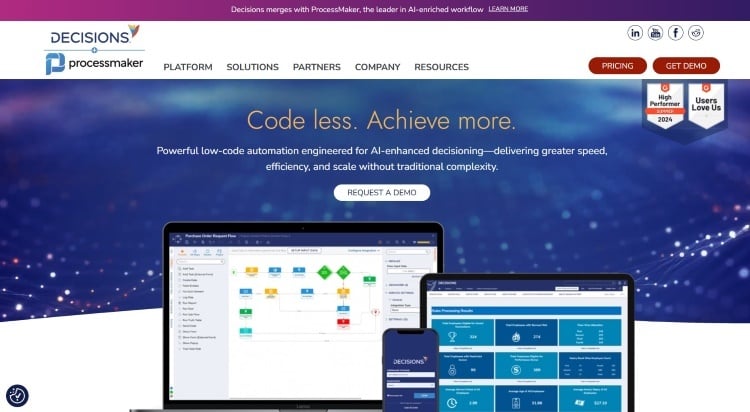Pipefy’s workflow automation tools make it easy to automate repetitive tasks, but as organizations grow, many struggle to scale complex business processes beyond basic workflows. Its limited customization, lack of a centralized dashboard, and higher costs for advanced features make scaling custom workflows and critical processes difficult.
As process automation becomes central to digital transformation, businesses are exploring Pipefy alternatives—no-code workflow management tools with an intuitive interface, seamless integration with existing systems, and the flexibility to drive operational efficiency and continuous improvement.
In this article, we explore:
- The top 10 Pipefy alternatives for 2026
- Key features, strengths, and pricing of the listed Pipefy alternatives
- Why FlowForma stands out as the most complete, transparent choice for scaling automation
Key Takeaways
|
Quick Overview Of The Top Pipefy Competitors in 2026
When evaluating alternatives to Pipefy, it’s clear that different tools cater to distinct automation needs—from quick wins for business users to deep enterprise-grade transformations.
Among all the compiled Pipefy alternatives, FlowForma, Kissflow, and Nintex deliver rapid automation for business teams.
Bizagi, Camunda, and Appian stand out for enterprise-scale transformations, while Creatio, Axon Ivy, Teamwork.com, and Decisions serve specialized process needs.
Here’s a brief overview of the listed tools:
|
Pipefy alternative |
Ideal for |
Key features |
AI and automation depth |
Pricing Transparency |
|
FlowForma |
Microsoft 365 users & regulated sectors |
AI-powered no-code process automation with built-in compliance |
Advanced (Copilot, Agent Rule, Summarization) |
Transparent, process-based |
|
Kissflow |
Mid-size enterprises |
Unified process and project management |
Moderate |
Tier-based |
|
Nintex |
Enterprises |
Process mapping and orchestration |
Moderate |
Custom quotes |
|
Appian |
Large organizations |
Enterprise-grade low-code platform |
High |
Enterprise-priced |
|
Bizagi |
Digital transformation projects |
Model-driven process workflows |
Moderate |
Custom quotes |
|
Camunda |
Developer-led teams |
Open-source process orchestration |
High (developer-based) |
Transparent |
|
Creatio |
CRM-centric automation |
Native CRM + workflow engine |
Moderate |
Transparent |
|
Axon Ivy |
Complex enterprise processes |
BPMN support + seamless integration |
Moderate |
Custom |
|
Teamwork.com |
Services teams |
Workflow and project management |
Basic |
Transparent |
|
Decisions |
Rules-driven organizations |
Visual workflow and decision engine |
Moderate |
Transparent |
Caption: Quick overview of the top 10 Pipefy alternatives in 2026
The Top 10 Pipefy Competitors in 2026
Let’s get into the detailed review of the best Pipefy alternatives.
1. FlowForma

Caption: FlowForma homepage
FlowForma is an AI-powered business process automation tool that enables users to automate complex workflows while IT defines the guardrails—security, integration, access controls, environments, and platform configuration. By delivering agility and autonomy without compromising compliance or control, this hybrid model empowers teams to design, deploy, and optimize their own workflows.
FlowForma integrates forms, workflows, document generation, analytics, and AI within Microsoft 365. Built for mid to large compliance-focused organizations, such as procurement, healthcare, and financial services, FlowForma delivers secure, fast, and transparent automation for end-to-end business processes.
FlowForma’s Key Features
The following are FlowForma’s key features:
1. Array of AI innovations for rapid process automation

Example of an onboarding prompt in FlowForma Copilot
FlowForma’s AI suite transforms how teams build and manage workflows.
Here’s how:
- AI Copilot: Converts plain text instructions or process diagrams into structured workflows in seconds, drastically reducing setup time.
- Agentic AI: Executes context-aware actions—reading invoices, validating data, updating systems—and delivers intelligent recommendations within workflows.
- Smart Assistants: Supports both builders and end users, offering step-by-step guidance, configuration help, and contextual prompts.
- AI Summarization: AI provides concise snapshots of ongoing processes, showing key decisions, blockers, and pending actions for faster approvals.
- Discovery Agent: Analyzes existing documentation and meeting conversations across departments to identify and suggest new automation opportunities, driving continuous improvement.
- AI Insights and Analytics: Monitors process performance, highlights inefficiencies, and recommends improvements.
2. True no-code automation
With FlowForma, citizen developers can build end-to-end workflows with minimal IT involvement while maintaining compliance with HIPAA, ISO, and GDPR. IT retains governance oversight while business users drive workflow automation.
 Caption: Top features of a no code platform
Caption: Top features of a no code platform
3. AI-powered document and form automation at scale
FlowForma enables teams to design dynamic digital forms that capture structured data at every step. Forms feed directly into document templates, generating reports, letters, contracts, and approval records instantly.
Ultimately, users get consistent, audit-ready documentation without manual effort or errors.
-
Seamless integration capabilities
FlowForma connects seamlessly with Microsoft 365 (SharePoint, Teams, and Outlook), including 1000+ third-party apps and systems through APIs and connectors.
 FlowForma integrations
FlowForma integrations
This ensures process data flows smoothly between departments, creating a single source of truth without complex middleware.
-
Built-in compliance and data security
All data processed through FlowForma remains securely stored within each client’s SharePoint tenancy. Every workflow automatically logs actions, timestamps, and version histories for complete auditability.
 Benefits of complance in workflow automation
Benefits of complance in workflow automation
Essentially, FlowForma’s built-in compliance module aligns with frameworks such as GDPR, ISO 27001, and HIPAA, supporting organizations in regulated industries and providing robust security and control.
FlowForm’s Pros
- Suite of explainable AI innovations (Copilot, Agentic AI, Summarization, Discovery Agent, and Smart Assistants) for faster process and workflow automation
- 10x faster automation than low-code or manual tools
- Intuitive interface for automating repetitive tasks
- Transparent pricing with unlimited workflows and no hidden costs
- In-built compliance and audit support enabling security and control
- Simple adoption with quick ROI and strong vendor support, ensuring customer success
- AI-powered analytics and instant report creation with visual dashboards for enhanced workflow and decision-making
FlowForma’s Cons
- Requires a SharePoint environment to operate
FlowForma’s Pricing
FlowForma uses a process-based pricing model where one license covers unlimited workflows. There are no surprise (hidden) fees or complicated tier structures to navigate.
This transparent approach makes it straightforward to budget and scale.
Unlike other Pipefy competitors that advertise free plans only later to introduce charges for essential features, FlowForma's pricing remains consistent as your automation requirements expand.
What do users say about FlowForma? (Success stories)
Once teams start using FlowForma, the difference is immediate. Processes that once depended on manual effort now run smoothly and intelligently in the background. Automation is effortless, freeing people to focus on work that really matters.
Here’s what users say about FlowForma:
%20(1)-1.png?width=550&height=367&name=Wills%20Quote%20(600%20x%20400%20px)%20(1)-1.png) Customer testimonial for FlowForma
Customer testimonial for FlowForma
Many highlight how its no-code design empowers business users to build and manage processes independently while maintaining IT control and compliance, as one G2 user noted.

Customer testimonial for FlowForma by Aon
Customers consistently praise the platform for its ease of use, no-code capabilities, and complete workflow automation.
📌Case study in highlight: AonGlobal insurance giant Aon replaced legacy processes with automated workflows that saved significant time and money. Prior to implementing FlowForma, business units managed information through disconnected Excel sheets and paper-based systems—methods misaligned with the company's IT-led digital transformation strategy.
Aon needed a single data repository—a centralized platform supporting automated, transparent, and auditable workflows that reinforced compliance. Already using SharePoint, the company sought better process automation within Microsoft 365. After implementing FlowForma, Aon achieved faster approvals, improved consistency, and stronger governance across departments—saving time, reducing manual effort, and advancing its digital transformation strategy. |
2. Kissflow
 Kissflow homepage
Kissflow homepage
Kissflow provides workflow, project, and case management in a single interface. It’s designed for mid-sized businesses that want fast setup and low-code flexibility without major IT dependence.
Kissflow Key Features
- Workflow and project templates for faster setup
- Unified dashboard for collaboration
- Integration with Google Workspace and Slack
- Analytics and reporting tools
Kissflow Pros
- Easy to use for non-technical users
- Fast implementation and deployment
- Affordable for smaller teams
Kissflow Cons
- Limited automation intelligence
- Minimal compliance governance
Suggested reading: Best alternatives to Kissflow
3. Nintex
 Nintex homepage
Nintex homepage
Nintex delivers enterprise-level process automation with a focus on mapping, RPA, and document generation. It’s suited for organizations seeking scalability and advanced orchestration.
Nintex Key Features
- Workflow designer and Promapp for mapping
- Document generation and e-signatures
- Robotic process automation (RPA)
- Integration with Microsoft 365 and Salesforce
Nintex Pros
- Strong for enterprise orchestration
- Extensive integration options
- Reliable for end-to-end workflow visibility
Nintex Cons
- Custom pricing with a high cost of ownership
- Requires setup and user training
Suggested reading: Top Nintex alternatives compared
4. Appian
 Appian homepage
Appian homepage
Appian is a low-code automation platform built for enterprise transformation. It supports complex workflows, case management, and AI-driven decisioning with strong compliance controls.
Appian Key Features
- Unified workflow and RPA environment
- AI decision-making engine
- Enterprise-grade security and compliance
- Flexible cloud or on-prem deployment
Appian Pros
- Ideal for large-scale operations
- Reliable data governance and control
- Advanced analytics and automation depth
Appian Cons
- High licensing costs
- Complex for smaller teams to manage
Suggested reading: Top Appian alternatives to consider
5. Bizagi
 Bizagi homepage
Bizagi homepage
Bizagi combines Business Process Model and Notation (BPMN) process design with automation and collaboration tools. It’s widely used by organizations focusing on digital transformation through structured process modeling.
Bizagi Key Features
- BPMN 2.0-compliant process modelling
- Process simulation and optimization
- Cloud and on-prem deployment
- Role-based access and collaboration
Bizagi Pros
- Strong for visual process mapping
- Effective for enterprise-grade automation
- Flexible integration with ERP and CRM tools
Bizagi Cons
- Limited AI assistance
- Requires technical expertise for scaling
6. Camunda
 Camunda homepage
Camunda homepage
Camunda is an open-source orchestration tool for teams building microservice-based workflows. It provides full control and scalability but requires developer involvement.
Camunda Key Features
- BPMN and Decision Model and Notation (DMN)-based workflow design
- API-first orchestration
- Advanced process analytics
- Developer SDK and open-source access
Camunda Pros
- Flexible for technical teams
- Highly scalable for distributed architectures
- Transparent open-source pricing
Camunda Cons
- Requires coding knowledge
- Not suitable for business users
7. Creatio
 Creatio homepage
Creatio homepage
Creatio integrates CRM, marketing, and process management within a single platform. It suits teams needing connected customer data and workflow automation in one view.
Creatio Key Features
- Built-in CRM and marketing automation
- Visual process designer
- Low-code app builder
- AI insights for customer journeys
Creatio Pros
- Unified CRM and process visibility
- Easy customization for teams
- Transparent, tiered pricing
Creatio Cons
- Limited AI automation outside CRM use
- Weak compliance reporting
Suggested reading: Top 10 Creatio alternatives to consider
8. Axon Ivy
 Axon Ivy homepage
Axon Ivy homepage
Axon Ivy is a scalable BPM platform for enterprises handling complex, rule-based workflows. It offers deep integration flexibility for IT-led automation projects.
Axon Ivy Key Features
- BPMN workflow engine
- Case management functionality
- Integration with SAP and Salesforce
- Multi-environment deployment options
Axon Ivy Pros
- Designed for enterprise-scale operations
- Reliable for complex system integration
- Stable performance and scalability
Axon Ivy Cons
- Technical setup required
- Limited AI-driven features
9. Teamwork.com
 Teamwork.com homepage
Teamwork.com homepage
Teamwork.com helps service businesses manage projects and workflows efficiently. It combines task tracking, collaboration, and billing management for client-facing teams.
Teamwork Key Features
- Project and workflow templates
- Built-in time tracking
- Client collaboration tools
- Reporting and Gantt charts
Teamwork Pros
- Great for service agencies
- Simple to deploy and use
- Affordable pricing structure
Teamwork Cons
- Basic automation
- Minimal compliance or governance
10. Decisions (now merged with Processmaker)
 Decisions homepage
Decisions homepage
Decisions is a visual rules-based process automation tool for organisations managing complex logic, particularly in finance and insurance.
Decisions Key Features
- Drag-and-drop rules engine
- Process and workflow designer
- API integrations for data exchange
- Advanced audit logging
Decisions Pros
- Excellent for rule-heavy workflows
- Highly customizable automation logic
- Strong compliance foundation
Decisions Cons
- Steep learning curve
- Less intuitive interface
Wrapping Up: Why FlowForma Is the Best Pipefy Alternative
When deciding on the best alternative for your team, consider the following points:
- For Microsoft 365 integration and AI-powered automation designed for enterprise-grade workflows and compliance requirements → FlowForma
- For quick, cost-effective deployment → Kissflow
- For enterprise-grade orchestration → Nintex
- For developer-led, complex automation → Camunda
- For CRM-connected workflows → Creatio
- For large-scale enterprise needs → Appian or Axon Ivy
While Pipefy is effective for workflow organization, FlowForma takes end-to-end automation to the next level, serving as a comprehensive business process automation solution.
Below is a side-by-side comparison of FlowForma vs Pipefy in terms of workflow design, scalability, pricing transparency, and other crucial factors:
|
Feature |
FlowForma |
Pipefy |
|
Workflow Design |
Fully no-code, natural-language builder |
No-code with predefined templates |
|
Ease of Use |
User-friendly drag-and-drop interface |
Easy to set up, limited customization for complex workflows |
|
AI Capabilities |
Copilot, Agentic AI, Smart Assistants, Summarization, Discovery Agent |
Limited AI automation features |
|
Document and Form Automation |
Built-in with templates and ISO-compliant document generation |
Basic document handling |
|
Microsoft 365 Integration |
Native and seamless |
Partial (via third-party connectors) |
|
Governance, Compliance & Security |
Built-in compliance modules, audit trails, and client-side data control |
Basic access permissions |
|
Pricing Model |
Transparent, process-based with unlimited workflows |
Tier-based pricing |
|
Deployment Speed |
Live within weeks |
Moderate |
|
Scalability |
Enterprise-ready across departments |
Best suited for SMBs and operations teams |
Streamline Your Business Operations And Complex Workflows With FlowForma
 Benefits yielded with FlowForma adoption
Benefits yielded with FlowForma adoption
For automating business processes in regulated industries and Microsoft-based organizations, FlowForma is the top Pipefy alternative in 2026. It combines AI-driven workflow automation, built-in compliance, and transparent pricing in a single no-code platform, enabling fast, secure, and scalable operations.
FlowForma provides the balance of simplicity and scalability, offering:
- No-code simplicity for rapid process creation in just a few hours
- AI-powered automation for smarter workflows
- Built-in compliance and auditability for regulated industries
- Transparent pricing for predictable scaling
- Seamless integration without legacy and existing software
- Native Microsoft 365 integration for easy adoption
FlowAssure, FlowForma’s latest AI-powered innovation, strengthens this ecosystem by automating vendor risk assessments and compliance reviews with AI-driven accuracy—helping businesses maintain security, governance, and trust across their operations.
For organizations ready to move beyond task-level automation to enterprise-scale digital transformation, FlowForma stands out as the most complete and future-ready Pipefy alternative in 2026.
Book a demo to see how quickly your business can go from manual to fully automated with FlowForma.
FAQs
1. What makes FlowForma’s AI-powered automation different from Pipefy’s?
FlowForma offers AI Copilot and Agent Rule for natural-language process building and intelligent decision-making. Unlike Pipefy’s basic automation, FlowForma drives real-time insights, compliance automation, and continuous improvements with AI-powered tools.
2. How does FlowForma handle compliance for regulated industries?
FlowForma’s FlowAssure automates vendor risk assessments and tracks certifications like ISO and SOC 2. It ensures audit-ready workflows and supports compliance without relying on external tools, making it perfect for regulated sectors.
3. Can FlowForma integrate with my existing software?
Yes, FlowForma integrates seamlessly with Microsoft 365 (SharePoint, Teams, Outlook) and over 1,000 third-party systems via APIs, ensuring smooth data flow and seamless integration with your existing systems and workflows.
4. What is FlowForma’s approach to scalability compared to other Pipefy alternatives?
FlowForma is highly scalable, offering a no-code platform that grows with your business. Unlike other tools, it allows teams to automate complex workflows across departments without the technical setup or steep learning curve.
5. What type of businesses benefit most from FlowForma’s process automation?
FlowForma is ideal for regulated industries like healthcare, finance, and construction, where compliance and process management are critical. It empowers business users to automate processes independently, while IT maintains oversight and governance.
 By
By 



